 Soviet Military Power
Soviet Military Power Soviet Military Power
Soviet Military Power
During the past decade, the Soviets allocated resources equivalent to approximately $400 billion to both strategic offensive and defensive programs in almost equal amounts roughly $20 billion per year for each program. Space programs during this same period approached $80 billion.
Since 1981, Soviet strategic nuclear offensive forces have been upgraded as deployment of a fourth generation of intercontinental ballistic missiles (ICBMs)(the SS-17, SS-18, and SS-19) was completed. In 1985, the Soviets introduced the road-mobile SS-25, and in 1987 they began deployment of the rail-mobile SS-24 ICBM. In the Soviet ballistic missile submarine fleet the TYPHOON, carrying 20 SS-N-20 MIRVed (multiple,independently-targetable reentry vehicles) missiles, was introduced, followed closely by the new DELTA IV carrying the even more capable SS-N-23. Soviet long-range bomber capabilities were enhanced by the introduction of the BEAR H carrying the AS-15 nuclear-armed cruise missile. Deployment of the new long-range strategic bomber, the BLACKJACK, is imminent.
In the area of strategic defense, the Soviets are modernizing the ballistic missile defense system around Moscow by replacing 64 old, reloadable above-ground GALOSH launchers with a two-layer defense composed of silo-based, long-range, modified GALOSH interceptor missiles; silo-based GAZELLE high acceleration end atmospheric interceptor missiles; and associated engagement, guidance, and battle management radar systems, including the new PILL BOX phased-array radar near Moscow at Pushkino. This phase of the modernization program should be completed in the late 1980s.
In space developments, the Soviets have orbited their MIR space station, established new endurance records for men in space, flight-tested a subscale model of what appears will become their space plane, and deployed a new medium-lift launcher, the SL-16. In addition, the Soviets launched their heavy-lift SL-X-17, capable of carrying payloads in excess of 100,000 kilograms. The SL-X-17 will also be used to launch the Soviet version of the space shuttle, which the Soviets acknowledge has undergone flight testing under its own power.
These are but a few examples of the trends in Soviet strategic programs. In this chapter, these and other trends, as well as future prospects, are discussed.
The Strategic Rocket Forces (SRF) constitute the Soviets' premier military service. Created in 1959 to control all long-range, land-based missiles with a range exceeding 1,000 kilometers, the SRF plays the dominant role in the Soviet strategic forces, controlling over 6,000 of the Soviets' 10,000 strategic warheads.
In a nuclear conflict, SRF missiles would attack:
- Enemy nuclear forces, including silos, missile sites, airfields, naval bases, weapons depots, and nuclear command-and-control facilities;
- Enemy power-projection assets, including military forces, ports, and transportation links; and
- Enemy civilian and military industrial facilities.
Soviet military planners anticipate having to launch their nuclear forces under a variety of circumstances. Thus, they have conducted training and built assets to support the following operations.
Preemption - To achieve the capability to execute this preferred option, the Soviets have emphasized the collection and processing of strategic intelligence concerning their potential enemies' intentions. If convinced that the time for nuclear preemption has come, the Supreme High Command would order a strategic strike. To ensure that the SRF will be ready, the Soviets conduct numerous test missile launches throughout the year, many of them from operational bases.
Launch on warning - The comprehensive Soviet planning for a nuclear war includes preparing their forces to perform their missions under the most adverse conditions. In the event the Soviets fail to execute their preemptive option, they will depend on their early warning networks to provide them with sufficient response time. This network comprises launch detection satellites and over-the-horizon radars that can ascertain the general direction of an attack and provide up to 30 minutes warning. Eleven HEN HOUSE radars located around the USSR, which will be augmented in the mid-199Os by nine new large phased-array radars, can confirm the attack and begin missile tracking. Once notified, the SRF would have to launch its missiles before enemy warheads hit. To ensure that it can do so, the SRF exercises the procedures involved in such a response.
 Launch after attack - Should the SRF not launch some or most of its missiles before an enemy attack, the Soviets have made provisions to help them survive the attack and conduct strikes in response. Their silos and launch control facilities, as well as their command, control, and communications links to the Supreme High Command, are hardened and highly survivable.
Launch after attack - Should the SRF not launch some or most of its missiles before an enemy attack, the Soviets have made provisions to help them survive the attack and conduct strikes in response. Their silos and launch control facilities, as well as their command, control, and communications links to the Supreme High Command, are hardened and highly survivable.
Command and communications entities also have mobile back-up units. To enhance survivability further, the Soviets have included both rail- and road-mobile missiles in their newest generation of ICBMs. Provisions have been made to refurbish and reload SRF silos, thereby enabling the Soviets to fire additional strategic missiles. These techniques will also be used after both sides' initial strikes during the period of prolonged nuclear conflict envisioned in Soviet doctrine.
 The period 1980 to 1988 witnessed the rapid modernization and sophistication of the Soviet ICBM arsenal. Soviet missiles have been upgraded or replaced with new models of greater accuracy and survivability. After 30 years of sustained growth and improvement, the Soviet Strategic Rocket Forces are extremely capable
of conducting global nuclear strikes. Yet improvements to this force continue unabated. By the mid-199Os, the Soviets will be fielding a completely new generation of increasingly accurate missiles, many of them mobile, posing a heightened threat to US strategic forces.
The Soviets maintain numerous SS- 11 and SS- 13 third-generation ICBMs. While these missiles are not capable of destroying hardened targets, they are fully capable of destroying unhardened targets.
The period 1980 to 1988 witnessed the rapid modernization and sophistication of the Soviet ICBM arsenal. Soviet missiles have been upgraded or replaced with new models of greater accuracy and survivability. After 30 years of sustained growth and improvement, the Soviet Strategic Rocket Forces are extremely capable
of conducting global nuclear strikes. Yet improvements to this force continue unabated. By the mid-199Os, the Soviets will be fielding a completely new generation of increasingly accurate missiles, many of them mobile, posing a heightened threat to US strategic forces.
The Soviets maintain numerous SS- 11 and SS- 13 third-generation ICBMs. While these missiles are not capable of destroying hardened targets, they are fully capable of destroying unhardened targets.
The centerpiece of the current Soviet SRF arsenal is the SS-18 heavy ICBM, designed to destroy hardened targets such as ICBM silos and command facilities. This missile, larger than the US PEACEKEEPER, has been modernized over the last seven years. The majority of the current force consists of SS-18 Mod 4s, which carry 10 MlRVed warheads. The SS-18 force alone could destroy 65 to 80 percent of all US ICBM silos using two warheads per target, and still have 1,000 warheads remaining. The total SS-18 force has about 3,000 warheads.
 The Soviets have also modernized their other two fourth-generation ICBMs, the SS-17 and SS-19. The SS- 19 Mod 3 carries six MIRVed warheads and is roughly comparable in size to the US PEACEKEEPER. The SS-17 Mod 3, while less accurate than the SS-18, carries four warheads and can destroy any unhardened
targets. Both the SS- 17 and SS- 19 are capable of flexible targeting: they can hit Eurasian as well as transoceanic targets with a total of about 2,700 warheads, thereby facilitating the Soviet Union's ability to adjust to the situation created by the Intermediate-range Nuclear Forces (INF) Treaty.
The Soviets have also modernized their other two fourth-generation ICBMs, the SS-17 and SS-19. The SS- 19 Mod 3 carries six MIRVed warheads and is roughly comparable in size to the US PEACEKEEPER. The SS-17 Mod 3, while less accurate than the SS-18, carries four warheads and can destroy any unhardened
targets. Both the SS- 17 and SS- 19 are capable of flexible targeting: they can hit Eurasian as well as transoceanic targets with a total of about 2,700 warheads, thereby facilitating the Soviet Union's ability to adjust to the situation created by the Intermediate-range Nuclear Forces (INF) Treaty.
The Soviets have invested enormous effort and resources in increasing the survivability of their strategic systems against nuclear attack. To make their fourth generation missiles survivable, for instance, the Soviets placed them in rebuilt, very hard silos. Of the Soviet inventory of 1,400 operational ballistic missile silos, 818 have been rebuilt since 1972. Fully one-half of these silos have been totally reconstructed and hardened since 1980.
The Soviets have begun operating fifth-generation ICBMs, missiles with great throwweight and accuracy. They use solid-fuel propellants (which provide longer life and require less maintenance), and are fully mobile, and hence highly survivable. The SS-24, currently in the initial stages of deployment, is comparable in size to the US PEACEKEEPER. It carries 10 warheads and is designed for both rail and silo deployment. The SS-25 is a road-mobile, 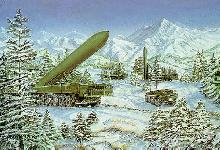 single-warhead, three-stage system. It can fire from field deployment sites or through the sliding roof garage it occupies at its base. The missile's mobility makes it inherently survivable and capable of reload/refire operations. The SS-25 joined operational Soviet SRF regiments in 1985.
single-warhead, three-stage system. It can fire from field deployment sites or through the sliding roof garage it occupies at its base. The missile's mobility makes it inherently survivable and capable of reload/refire operations. The SS-25 joined operational Soviet SRF regiments in 1985.
By the 1990s, assuming the continuation of the current modernization tempo, the Soviets will be in a position to field over 15,000 warheads. Additionally, these weapons would be placed on newer, more capable and survivable strategic delivery systems during the next decade. It is likely that by the mid-199Os, the Soviets will have completely phased out their third-generation missiles, while the fourth-generation will be undergoing replacement by systems currently in development and testing. The SS-18 Follow-On, a more accurate version than its predecessor, has been tested recently; preparations for deployment of this missile are already underway. In October 1987, the US protested the apparent Soviet intention to test the SS-18 Follow-On in such a manner as to have its reentry vehicles land in the Pacific extremely close to the major populated islands of Hawaii. Mobile, solid-fueled SS-24s and SS-25s will be fully operational and will themselves be replaced by follow-on systems in the next decade. These advances will ensure that the Soviet ICBM force will remain the world's largest and most modern strategic missile force.
 The Soviet Navy operates the world's largest strategic missile submarine force. Although it includes some older submarines, the majority of the nuclear-powered ballistic missile submarine (SSBN) force consists of more
modern DELTA I, II, and III submarines armed with intercontinental-range missiles that can reach North America from Soviet ports and coastal waters.
The Soviet Navy operates the world's largest strategic missile submarine force. Although it includes some older submarines, the majority of the nuclear-powered ballistic missile submarine (SSBN) force consists of more
modern DELTA I, II, and III submarines armed with intercontinental-range missiles that can reach North America from Soviet ports and coastal waters.
 Within the last seven years, the Soviets have introduced the TYPHOON and the DELTA IV, both equipped with more accurate, longer range MIRVed intercontinental missiles. The introduction of these systems has enabled the Soviets to increase their SLBM weapons delivery capabilities by nearly 30 percent without increasing the overall size of their SSBN force. At the same time, submarine survivability was being significantly enhanced.
Within the last seven years, the Soviets have introduced the TYPHOON and the DELTA IV, both equipped with more accurate, longer range MIRVed intercontinental missiles. The introduction of these systems has enabled the Soviets to increase their SLBM weapons delivery capabilities by nearly 30 percent without increasing the overall size of their SSBN force. At the same time, submarine survivability was being significantly enhanced.
 Based in the Pacific Ocean and Northern Fleet areas, the Soviet ballistic missile submarine force is equipped with over 3,000 warheads on submarine-launched ballistic missiles (SLBMs). In wartime, a portion of these forces is expected to serve as a survivable nuclear reserve. In the last decade, the deployment of multiple warhead SLBMs with ranges sufficient to reach the United States from waters near the USSR has allowed the Soviets to plan to operate the majority of their SSBNs in protected "bastions," or havens, near the Soviet Union. Mixed groups of naval air, surface, and submarine assets, along with fixed sensors and minefields, will operate in wartime to protect these SSBN bastion areas against US/NATO antisubmarine forces.
Based in the Pacific Ocean and Northern Fleet areas, the Soviet ballistic missile submarine force is equipped with over 3,000 warheads on submarine-launched ballistic missiles (SLBMs). In wartime, a portion of these forces is expected to serve as a survivable nuclear reserve. In the last decade, the deployment of multiple warhead SLBMs with ranges sufficient to reach the United States from waters near the USSR has allowed the Soviets to plan to operate the majority of their SSBNs in protected "bastions," or havens, near the Soviet Union. Mixed groups of naval air, surface, and submarine assets, along with fixed sensors and minefields, will operate in wartime to protect these SSBN bastion areas against US/NATO antisubmarine forces.
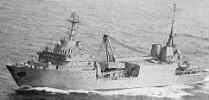 Additionally, within the last several years the Soviet Navy has increased greatly its interest in the Arctic as an area of military operations, particularly for its SSBNs. The Soviets think that SSBN operations in the Arctic ice zone could increase submarine survivability, based on
their belief that operations under and near the Arctic ice pack might provide their deployed SSBNs with greater security and protection than in more exposed waters.
Additionally, within the last several years the Soviet Navy has increased greatly its interest in the Arctic as an area of military operations, particularly for its SSBNs. The Soviets think that SSBN operations in the Arctic ice zone could increase submarine survivability, based on
their belief that operations under and near the Arctic ice pack might provide their deployed SSBNs with greater security and protection than in more exposed waters.
 To ensure that they can communicate with their SSBN/SLBM assets, the Soviets have recently improved their submarine command, control, and communications (C3) systems by deploying an extremely low frequency (ELF) communications system. Newly deployed BEAR J aircraft offer an additional means of effective SSBN communication redundancy by providing very low frequency (VLF) communication transmissions to SSBNs on patrol.
To ensure that they can communicate with their SSBN/SLBM assets, the Soviets have recently improved their submarine command, control, and communications (C3) systems by deploying an extremely low frequency (ELF) communications system. Newly deployed BEAR J aircraft offer an additional means of effective SSBN communication redundancy by providing very low frequency (VLF) communication transmissions to SSBNs on patrol.
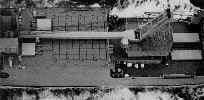 The Soviets may begin at-sea flight testing of a modified version of the SS-N-20 missile sometime this year. A modified version of the SS-N-23 missile will probably complete testing in 1988. Improved accuracy of the Soviets' latest SLBM systems, as well as possible efforts to increase SLBM reentry vehicle size and warhead yield, would confirm Moscow's plans to
develop a hard-target-kill capability for its SLBM force. The new missile support ship class, the ALEXANDER BRYKIN, is designed to reload SSBNs with these modern missiles. This capability will allow Soviet SSBNs to hold additional targets at risk.
The Soviets may begin at-sea flight testing of a modified version of the SS-N-20 missile sometime this year. A modified version of the SS-N-23 missile will probably complete testing in 1988. Improved accuracy of the Soviets' latest SLBM systems, as well as possible efforts to increase SLBM reentry vehicle size and warhead yield, would confirm Moscow's plans to
develop a hard-target-kill capability for its SLBM force. The new missile support ship class, the ALEXANDER BRYKIN, is designed to reload SSBNs with these modern missiles. This capability will allow Soviet SSBNs to hold additional targets at risk.
 The Soviet intercontinental bomber force has historically lagged behind the SRF and navy in systems development. Recent Soviet efforts in strategic aviation, however, particularly with the
BEAR H and BLACKJACK long-range bombers, signal heightened interest in a manned-bomber attack force to diversify the character of their strategic forces.
The Soviet intercontinental bomber force has historically lagged behind the SRF and navy in systems development. Recent Soviet efforts in strategic aviation, however, particularly with the
BEAR H and BLACKJACK long-range bombers, signal heightened interest in a manned-bomber attack force to diversify the character of their strategic forces.
The BLACKJACK is the world's largest and heaviest bomber. Designed to carry bombs and air-launched cruise missiles (ALCMs), the BLACKJACK can cruise subsonically over long ranges, perform high-altitude supersonic dash, and attack utilizing low-altitude, high subsonic penetration maneuvers. As with the B-l, the BLACKJACK has a blended wing-body design with a variable-sweep wing and a single vertical stabilizer.  It has an unrefueled combat radius of about 7,300 kilometers and a maximum speed of Mach 2.0. Eleven BLACKJACK bombers have been produced, and the first BLACKJACK regiment should begin forming this year. The backbone of the modern Soviet intercontinental bomber force of the 1980s, however, will remain the BEAR H, armed with the AS-15/KENT ALCM. The Soviets also have in their inventory about 100 other BEAR bombers and air-to-surface missile carriers. The BEAR was first produced in the late 1950s, but some of these aircraft have been updated in subsequent years with new technology.
It has an unrefueled combat radius of about 7,300 kilometers and a maximum speed of Mach 2.0. Eleven BLACKJACK bombers have been produced, and the first BLACKJACK regiment should begin forming this year. The backbone of the modern Soviet intercontinental bomber force of the 1980s, however, will remain the BEAR H, armed with the AS-15/KENT ALCM. The Soviets also have in their inventory about 100 other BEAR bombers and air-to-surface missile carriers. The BEAR was first produced in the late 1950s, but some of these aircraft have been updated in subsequent years with new technology.
 Soviet strategic aviation capabilities are enhanced through training and exercises. BEAR H bombers are regularly observed simulating attacks against North America. When operational, the BLACKJACK can be expected to engage in similar operations. Additionally, older BEAR bombers carrying the AS-3 air-to-surface missile (ASM) are being rejuvenated through a modification program that upgrades them to carry the newer AS-4 supersonic ASM. More than 45 of these reconfigured aircraft, designated BEAR Gs, are now operational.
Soviet strategic aviation capabilities are enhanced through training and exercises. BEAR H bombers are regularly observed simulating attacks against North America. When operational, the BLACKJACK can be expected to engage in similar operations. Additionally, older BEAR bombers carrying the AS-3 air-to-surface missile (ASM) are being rejuvenated through a modification program that upgrades them to carry the newer AS-4 supersonic ASM. More than 45 of these reconfigured aircraft, designated BEAR Gs, are now operational.
The current Soviet intercontinental bomber force is more flexible and survivable than it has ever been. Prior to the recent introduction of longer range cruise missiles, Soviet bombers would have had to penetrate Canadian or US airspace to launch their attacks. Now the BEAR H can launch its long-range AS-15 cruise missiles from well offshore and still hit targets in North America. The BLACKJACK will be able to conduct both standoff and penetration attacks using a variety of nuclear missiles and bombs.
 Until recently, the Soviets had only aging BISON tankers for aerial refueling support of BISON and BEAR aircraft. In 1987, the first unit of new MIDAS tankers entered operational service. While the BISON tankers remain in service, they are expected to be replaced as sufficient numbers of MIDAS tankers become available.
Until recently, the Soviets had only aging BISON tankers for aerial refueling support of BISON and BEAR aircraft. In 1987, the first unit of new MIDAS tankers entered operational service. While the BISON tankers remain in service, they are expected to be replaced as sufficient numbers of MIDAS tankers become available.
The Soviets are on the verge of deploying a variety of sophisticated cruise missile systems. At sea, the Soviets have tested the SS-N-21 sea-launched cruise missile (SLCM). A variety of Soviet general purpose attack submarines such as VICTORs, AKULAs, or SIERRAs could carry and launch the SS-N-21. Additionally, a YANKEE-Class nuclear submarine has been converted to carry SS-N-21 missiles. Targets in either Eurasian or North American theaters could be attacked by these accurate missiles, which are fitted with nuclear warheads. The larger SS-NX-24 missile, which could be carried from specialized submarine platforms such as a modified YANKEE, is expected to be operational in the next few years.
The Soviets have deployed an air-launched long range cruise missile the AS-15/KENT with their intercontinental-range BEAR H force. Armed with this standoff weapon, the BEARs pose a much greater threat to Eurasian and US targets. Work on a new bomber-launched cruise missile is underway.
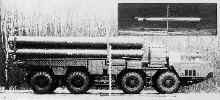 The Soviets had developed and were preparing to deploy a ground-launched cruise missile (GLCM)the SSC-X-4 which is a version of the SS-N-21/AS-15 system. A GLCM-variant of the larger SS-NX-24 was also a possibility as a theater strike weapon. Both GLCM systems are banned by the INF Treaty.
The Soviets had developed and were preparing to deploy a ground-launched cruise missile (GLCM)the SSC-X-4 which is a version of the SS-N-21/AS-15 system. A GLCM-variant of the larger SS-NX-24 was also a possibility as a theater strike weapon. Both GLCM systems are banned by the INF Treaty.
In addition to ICBMs, the SRF is responsible for intermediate-range (IRBM) and medium-range (MRBM)ballistic missiles the latter two being longer range intermediate-range nuclear forces. The INF Treaty will eliminate these Soviet systems. Until the treaty enters into force and the missiles are destroyed as required over a three-year period, INF systems, such as the SS-20, will continue to pose a threat to Eurasian targets.
The last seven years have seen the full expansion and deployment of the Soviet SS-20 IRBM force, from approximately 250 SS-20s in 1980 to a high of 441. The less capable SS-4 MRBM force has been reduced in size during this period, and now numbers approximately 50 missile launchers.
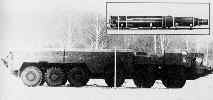 The SS-20 is a remarkably capable IRBM system which first became operational in 1977. The missile carries three highly accurate MIRVed warheads and can deliver them out to a range of about 5,000 kilometers. It has a reliable solid-fuel propellant system and is fully mobile, making countertargeting efforts extremely difficult. It can fire either from sliding-roof garages at regimental bases or from field-deployed sites. The Soviets have the capability to reload and refire SS-20s. The older SS-4 system is still maintained at the theater level. This liquid-fueled system is located at soft launching sites. The missile can deliver one warhead out to a range of 2,000 kilometers.
The SS-20 is a remarkably capable IRBM system which first became operational in 1977. The missile carries three highly accurate MIRVed warheads and can deliver them out to a range of about 5,000 kilometers. It has a reliable solid-fuel propellant system and is fully mobile, making countertargeting efforts extremely difficult. It can fire either from sliding-roof garages at regimental bases or from field-deployed sites. The Soviets have the capability to reload and refire SS-20s. The older SS-4 system is still maintained at the theater level. This liquid-fueled system is located at soft launching sites. The missile can deliver one warhead out to a range of 2,000 kilometers.
These missile forces can be augmented or replaced by a variety of other nuclear delivery systems. The Soviets retain 12 older GOLF II diesel-powered ballistic missile submarines, six of which are assigned to the Baltic Fleet. Each GOLF can deliver three SS-N-5 missiles on Eurasian targets. Additionally, Soviet aviation assets, particularly the BACKFIRE and FENCER, can conduct theater nuclear operations.
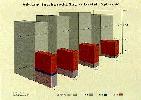 The role of Soviet INF missiles will likely be redistributed to other systems in light of the recent INF Treaty. The treaty requires the destruction without replacement of all existing missiles and launchers over a three-year period, including the SS-20, SS-4, and SS-5 ballistic missiles, as well as the SSC-X-4 cruise missile, which was tested but not deployed. After the agreement takes effect, however, the Soviets maybe able to turn to other strategic ballistic missiles (ICBMs and SLBMs), aircraft, and perhaps sea-launched cruise missiles to fulfill their strategic theater requirements in Eurasia.
The role of Soviet INF missiles will likely be redistributed to other systems in light of the recent INF Treaty. The treaty requires the destruction without replacement of all existing missiles and launchers over a three-year period, including the SS-20, SS-4, and SS-5 ballistic missiles, as well as the SSC-X-4 cruise missile, which was tested but not deployed. After the agreement takes effect, however, the Soviets maybe able to turn to other strategic ballistic missiles (ICBMs and SLBMs), aircraft, and perhaps sea-launched cruise missiles to fulfill their strategic theater requirements in Eurasia.
The Soviet military also deploys a wide variety of nuclear delivery systems with a range less than 1,000 kilometers. These include shorter range intermediate-range nuclear forces (SRINF) missiles, which are covered by the INF Treaty. Specifically, the SCALEBOARD and SS-23/SPIDER will be eliminated within 18 months after the treaty enters into force. The INF Treaty does not cover short-range nuclear missiles with a range less than 500 kilometers, dual-capable aircraft, and artillery pieces. Thus, while the INF Treaty eliminates the most threatening Soviet nuclear systems, the Soviets will retain a more than adequate capability to provide tactical nuclear support for their ground forces.
The SRINF systems eliminated by the INF Treaty had posed new challenges to NATO during the 1980s. At the theater- and front-level, the older SCALEBOARD had been replaced by a modernized version. The modification significantly improved the missile's accuracy while maintaining its 900-kilometer range. Until 1983, the SCALEBOARD had not been deployed outside the USSR. In 1984, one brigade was deployed in Czechoslovakia, and two brigades were deployed in East Germany. SCALEBOARD units are also located in the western Soviet Union, and in the Central Asian and the Far Eastern USSR. Over 100 SCALEBOARD missiles remain in the inventory.
At the front- and army-levels, the SS-23/SPIDER was designed as the successor to the 1960's vintage SCUD. Over 75 are now in the inventory. With improvements in accuracy, responsiveness, and range, the SS-23 poses a greater threat to time-critical targets such as NATO nuclear missile units, airfields, and air defense sites. The SPIDER has been deployed since 1985 in several locations within the USSR and was recently introduced into East Germany. Over 600 SCUD missiles, however, remain deployed. Although SCALEBOARDs, SPIDERs, and SCUDs could be deployed with chemical or conventional high-explosive warheads, their principal role is to serve as the ground force's primary nuclear fire support means.
The Soviet military also operates tactical nuclear missile and artillery systems deployed at front level. At the division-level, nuclear fire support is provided by 660 free-rocket-over-ground (FROG) missiles, deployed in battalions of four launchers (one in each division). In 1981, the SS-21, a guided missile (providing improvement in both range and accuracy), began replacing the FROG in forward-deployed divisions, and 140 are now deployed. Division-level SS-21 battalions are being consolidated into brigades in Soviet armies in East Germany.
Soviet nuclear-capable artillery and mortars underwent qualitative improvements in the 1980s, with the replacement of older, towed-artillery pieces with self propelled (SP) versions. These SP weapons, including the 152-mm howitzer 2S3, the 152-mm gun 2S5, the 203-mm gun 2S7, and the 240-mm 2S4 mortar, enable the Soviets to provide more responsive nuclear support for their ground maneuver units.
In a dramatic departure from past assertions that only the United States is working to "militarize" space, General Secretary Gorbachev acknowledged on 30 November 1987 that the USSR is involved in strategic defense research. He stated, "The Soviet Union is doing all that the United States is doing, and I guess we are engaged in research, basic research, which relates to these aspects which are covered by the SDI of the United States." But the Soviet effort into all aspects of strategic defense has been consistently far more vigorous than that of the United States.
The Soviets maintain the world's only operational ABM system, and a nearly completed construction program begun during the 1980s will yield an expanded and upgraded system comprising a two-layer defense of 100 launchers. When fully operational around 1989, the system will defend selected leadership and strategic facilities in the Moscow area.
 The new Moscow ABM system includes two interceptor missiles: a long-range modified GALOSH ABM that is intended to engage ballistic missile reentry vehicles(RVs) outside the atmosphere; and the GAZELLE, a shorter range, high-acceleration missile that, like the
now-defunct US SPRINT system, is designed to engage RVs after they have reentered the Earth's atmosphere. New, hardened silos have been constructed for the new interceptor missiles. The modified GALOSH and GAZELLE are expected to become operational in 1988 or 1989.
The new Moscow ABM system includes two interceptor missiles: a long-range modified GALOSH ABM that is intended to engage ballistic missile reentry vehicles(RVs) outside the atmosphere; and the GAZELLE, a shorter range, high-acceleration missile that, like the
now-defunct US SPRINT system, is designed to engage RVs after they have reentered the Earth's atmosphere. New, hardened silos have been constructed for the new interceptor missiles. The modified GALOSH and GAZELLE are expected to become operational in 1988 or 1989.
A large multifunction phased-array radar nearing completion at Pushkino is also an integral part of the new Moscow ABM system. The radar, which has 360-degree coverage, will provide support for the new interceptor systems. It is expected to reach full operational capability around 1989.
In the aggregate, the Soviet Union's ABM and ABM related actions suggest that the USSR may be preparing an ABM defense of its national territory. These actions include radar construction, concurrent testing, SAM upgrade, ABM rapid reload, ABM mobility, and deployment of ABM components to Gomel.
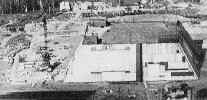 The Soviets began building a large phased-array radar (LPAR) network in the 1970s, and since 1981 the number of LPARs under construction has more than doubled. There are now nine LPARs in varying stages of completion, forming a nearly complete ring of ballistic missile detection coverage for the Soviet landmass. They duplicate and augment coverage provided by the older HEN HOUSE ballistic missile early warning radars, but also could provide the detailed detection and tracking data which would be required for a nationwide ABM system. Since these radars take a long time to construct, the entire network probably would not be operational until the mid-199Os.
The Soviets began building a large phased-array radar (LPAR) network in the 1970s, and since 1981 the number of LPARs under construction has more than doubled. There are now nine LPARs in varying stages of completion, forming a nearly complete ring of ballistic missile detection coverage for the Soviet landmass. They duplicate and augment coverage provided by the older HEN HOUSE ballistic missile early warning radars, but also could provide the detailed detection and tracking data which would be required for a nationwide ABM system. Since these radars take a long time to construct, the entire network probably would not be operational until the mid-199Os.
 The Soviets have deployed and tested components required for an ABM system that could be deployed to a site in months rather than years. Recent Soviet activities with respect to moving a FLAT TWIN ABM radar and a PAWN SHOP van, both components of an ABM system, from a test range and initiating deployment at a location outside an ABM deployment area or ABM test range, constitute a violation of the ABM Treaty. Moreover, the SA-10/SAM system already in the air defense forces may have the potential to intercept some types of ballistic missiles, as may the SA-X-12B/GIANT when it is deployed.
The Soviets have deployed and tested components required for an ABM system that could be deployed to a site in months rather than years. Recent Soviet activities with respect to moving a FLAT TWIN ABM radar and a PAWN SHOP van, both components of an ABM system, from a test range and initiating deployment at a location outside an ABM deployment area or ABM test range, constitute a violation of the ABM Treaty. Moreover, the SA-10/SAM system already in the air defense forces may have the potential to intercept some types of ballistic missiles, as may the SA-X-12B/GIANT when it is deployed.
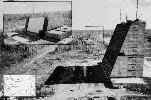 One of the principal concerns regarding Soviet noncompliance with the ABM Treaty is the Krasnoyarsk radar, which is in clear violation of the treaty. The only permitted functions for an LPAR with Krasnoyarsk's location and orientation would be space-tracking and National Technical Means (NTM) of verification. Conclusive evidence suggests, however, that this radar is primarily designed for ballistic missile detection and tracking, not for space-tracking and NTM as the Soviets claim. Moreover, the coverage of the Krasnoyarsk radar closes a major gap in the coverage of the Soviet ballistic missile detection, warning, and tracking screen. The location of the Krasnoyarsk radar allows it to provide warning of a ballistic missile attack, to acquire attack characterization data that will enable the Soviet strategic forces to respond in a timely manner, and to aid in the battle management of Soviet strategic defensive forces. All LPARs, including the Krasnoyarsk radar, have the inherent capability to track large numbers of objects accurately. Thus, they not only could perform as
ballistic missile detection, warning, and tracking radars, but also have an inherent technical potential, depending on location and orientation, of contributing to ABM battle management. A US Congressional delegation visited the Krasnoyarsk LPAR facility on 5 September 1987 and was allowed to view selected areas of both the transmitter and receiver facilities. No information derived from this visit, however, changed the assessment
that the radar is designed for ballistic missile detection and tracking.
One of the principal concerns regarding Soviet noncompliance with the ABM Treaty is the Krasnoyarsk radar, which is in clear violation of the treaty. The only permitted functions for an LPAR with Krasnoyarsk's location and orientation would be space-tracking and National Technical Means (NTM) of verification. Conclusive evidence suggests, however, that this radar is primarily designed for ballistic missile detection and tracking, not for space-tracking and NTM as the Soviets claim. Moreover, the coverage of the Krasnoyarsk radar closes a major gap in the coverage of the Soviet ballistic missile detection, warning, and tracking screen. The location of the Krasnoyarsk radar allows it to provide warning of a ballistic missile attack, to acquire attack characterization data that will enable the Soviet strategic forces to respond in a timely manner, and to aid in the battle management of Soviet strategic defensive forces. All LPARs, including the Krasnoyarsk radar, have the inherent capability to track large numbers of objects accurately. Thus, they not only could perform as
ballistic missile detection, warning, and tracking radars, but also have an inherent technical potential, depending on location and orientation, of contributing to ABM battle management. A US Congressional delegation visited the Krasnoyarsk LPAR facility on 5 September 1987 and was allowed to view selected areas of both the transmitter and receiver facilities. No information derived from this visit, however, changed the assessment
that the radar is designed for ballistic missile detection and tracking.
Since the 1960s, the Soviets have been conducting a substantial research program to develop a defense against ballistic missiles. As noted by General Secretary Gorbachev, this effort covers many of the same technologies currently being explored by the US SDI. The Soviet effort, however, involves a much greater investment of plant space, capital, and manpower.
For example, the Soviet laser research program, with ballistic missile defense applicability, has historically been much larger than its US counterpart. At Sary Shagan, one of a half-dozen major R&D facilities involved in laser research, the Soviets are believed to be developing several lasers for strategic applications such as air defense or a terminal ABM, and at least one laser believed capable of an antisatellite mission.
Moscow hopes that its huge investment to design and build high-energy lasers will provide it with laser systems for strategic air defense, space-based antisatellite missions and, conceivably, defense against ballistic missiles. The first prototype systems, some with limited operational capability, might be seen before the end of the decade, but except for air defense, full-scale, fully operational defensive systems are not expected until the late 1990s at the earliest.
In some areas of ballistic missile defense-related technology, the USSR has progressed beyond technology research. It has ground-based lasers with some capability to attack US satellites, and it could have a space-based antisatellite laser prototype within the next several years. The Soviets also could have ground-based laser prototypes for ballistic missile defense in the early 1990s, and they could begin testing a limited-scale deployment system in the late 1990s.
Moscow is exploring several other advanced technologies for use in ballistic missile defense. Since the late 1960s, for instance, the Soviets have explored the use of particle beam and kinetic energy weapons for antisatellite (ASAT) and ballistic missile defense missions. Although the Soviets may be able to test a prototype particle beam ASAT weapon in the mid-to-late 1990's, operational systems that could destroy satellites or incoming ballistic missiles will not exist until the 21st century.
Long-range, space-based kinetic energy weapons for defense against ballistic missiles probably could not be developed until at least the mid-199Os. The Soviets could, however, deploy a short-range, space-based system for space station defense or close-in attack by a maneuvering satellite in the near future.
The USSR has also conducted research in the use of radio-frequency weapons to interfere with or destroy the electronic components of ballistic missile warheads or satellites. A ground-based version of such a weapon could be tested in the 1990s. Free-electron lasers, which generate intense microwave and millimeter-wave pulses, have been developed by the Soviets, possibly for use in radio-frequency weapons.
The Soviet passive defense program is a comprehensive system of measures designed to inhibit the effects of a nuclear attack on the Soviet Union. The main objectives of the passive defense program in effect today are: ensuring the survival and continuity of the Soviet leadership; planning for efficient wartime mobilization of manpower and the economy; protecting the industrial base and essential workers; and providing a credible reconstitution capability. Integral to the Soviet passive defense program are thousands of hardened facilities.
Deep Underground Facilities
For 40 years, the Soviet Union has had a vast program underway to ensure the survival of the leadership in the event of nuclear war. This multifaceted program has involved the construction of deep underground bunkers, tunnels, secret subway lines, and other facilities beneath Moscow, other major Soviet cities, and the sites of major military commands. This program is designed solely to protect the senior Soviet leadership from the effects of nuclear war. These deep underground facilities today are, in some cases, hundreds of meters deep and can accommodate thousands of people. As nuclear arsenals on both sides have become larger and more potent, these facilities have been expanded and have reached greater depths.
Neither changes in the Soviets' leadership nor the restructuring of the strategic balance and the refinements in military doctrine that accompanied these changes appear to have diminished their commitment to the program. Over the program's history, its purpose has remained unchanged leadership survival so that it can maintain internal control and ensure that Soviet military power can be centrally directed throughout all phases of a world war. The secrecy of the program and the uncertainty about the extent and nature of these facilities are major causes for concern.
The deep underground program, which rivals Soviet offensive strategic weapons programs both in scale and level of commitment, remained undiminished even as the Soviets agreed to limit their defenses against ballistic missiles in the ABM Treaty. Indeed, a major augmentation of the original activities was started about the time the ABM Treaty was being concluded. Yet another round of construction on these complexes began in the early 1980s, when Soviet leaders were publicly emphasizing that a nuclear war would be so catastrophic that attempts to achieve victory or even seriously limit damage in such a war no longer made sense. The latest round of construction coincided with intensified Soviet preparations for the possibility that a nuclear war could be protracted.
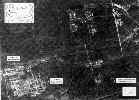 The deep underground facilities beneath the city of Moscow are directly associated with the main centers of state power. They provide the leaders of the various organs of state control the opportunity to move from their peacetime offices through concealed entry ways down
to protective quarters below the city, in some cases,hundreds of meters down. Once there, the Politburo, the Central Committee, the Ministry of Defense, the KGB, and the apparatuses of the many other state ministries can remain sheltered while the USSR converts to a wartime posture. The fruits of this 40-year construction program now offer the Soviet wartime leadership the option of remaining beneath Moscow or, at some point,
boarding secret subway lines connecting these deep
underground facilities. From there the Soviets can make
their way to nearby underground complexes outside
Moscow where they plan to survive nuclear strikes and
to direct the war effort. The support infrastructure
for these facilities is substantial. A highly redundant
communications system, consisting of both on-site and
remote elements, supports these complexes and permits
the leadership to send orders and receive reports through
the wartime management structure.
The deep underground facilities beneath the city of Moscow are directly associated with the main centers of state power. They provide the leaders of the various organs of state control the opportunity to move from their peacetime offices through concealed entry ways down
to protective quarters below the city, in some cases,hundreds of meters down. Once there, the Politburo, the Central Committee, the Ministry of Defense, the KGB, and the apparatuses of the many other state ministries can remain sheltered while the USSR converts to a wartime posture. The fruits of this 40-year construction program now offer the Soviet wartime leadership the option of remaining beneath Moscow or, at some point,
boarding secret subway lines connecting these deep
underground facilities. From there the Soviets can make
their way to nearby underground complexes outside
Moscow where they plan to survive nuclear strikes and
to direct the war effort. The support infrastructure
for these facilities is substantial. A highly redundant
communications system, consisting of both on-site and
remote elements, supports these complexes and permits
the leadership to send orders and receive reports through
the wartime management structure.
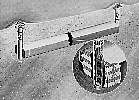 These installations also have highly effective life support systems capable of protecting their occupants
against chemical and biological attack. Such arrangements may enable independent operations to be carried out from these facilities for many months. The top leadership of the USSR also has the option of going by secret subway lines out to Vnukovo Airfield, about 17 miles southwest of the Kremlin, and from there flying to remote facilities. They also have a fleet of aircraft, trains, and other vehicles that provide yet another option for survival; these platforms have extensive communications support, which would permit the surviving leadership to reconstitute Soviet military power for ensuing military operations. While Soviet preparations for leadership protection are most intensive around Moscow because of its critical role in wartime management, there are similar programs in other key cities. Moreover, Soviet planning calls for the leadership's evacuation from several hundred additional cities to rural relocation facilities.
These installations also have highly effective life support systems capable of protecting their occupants
against chemical and biological attack. Such arrangements may enable independent operations to be carried out from these facilities for many months. The top leadership of the USSR also has the option of going by secret subway lines out to Vnukovo Airfield, about 17 miles southwest of the Kremlin, and from there flying to remote facilities. They also have a fleet of aircraft, trains, and other vehicles that provide yet another option for survival; these platforms have extensive communications support, which would permit the surviving leadership to reconstitute Soviet military power for ensuing military operations. While Soviet preparations for leadership protection are most intensive around Moscow because of its critical role in wartime management, there are similar programs in other key cities. Moreover, Soviet planning calls for the leadership's evacuation from several hundred additional cities to rural relocation facilities.
The Soviets also use worked-out mines to increase the number of relocation facilities. These old mines have the added advantage of reducing the cost of the passive defense program since the excavation costs have already been recovered. The mines would also provide concealed storage sites for military stores and equipment, expanded storage capacity for the strategic stocks reserve network, and improved continuity of economic activity in wartime. By using these old mines,the Soviets can expand the already large number of underground facilities available for leadership protection quickly and inexpensively.
The Soviets' experience with civil defense, leadership protection, and massive relocation efforts during World War II has taught them the benefits of a leadership protection program. While continuing improvements indicate the program does not yet fully meet Soviet requirements, the Soviets have made extensive preparations to give the leadership the potential for effective performance in a nuclear war. The enormous and continuing Soviet investments in the leadership protection program indicate that they believe its benefits are well worth the large cost. Unceasing efforts in strategic offensive forces and active defensive forces modernization, when coupled with efforts to protect the leadership, clearly indicate that the USSR expects to exercise national command and control through all phases of protracted nuclear war.
The continuing evolution of Soviet military space doctrine, the increasing number of military-related launches, and the high priority given to development of space-related strategic offensive and defensive systems reflect the Soviet determination to use space primarily for military purposes. The long-term Soviet commitment to space was reaffirmed by General Secretary Gorbachev in May 1987 when he declared, "We do not intend to relax our efforts and lose our vanguard position in the conquest of space."
The Soviets currently operate about 50 types of space systems for military and civilian uses, including manned space stations (MIR and the inactive SALYUT 7), and reconnaissance, launch-detection, navigational, meteorological, and communications satellites. Some types of satellites - the Soviet space station, the materials processing satellite, the radar ocean reconnaissance satellite (RORSAT), the electronic intelligence(ELINT) ocean reconnaissance satellite (EORSAT), and the radar-carrying oceanographic satellite are unique to the Soviets.
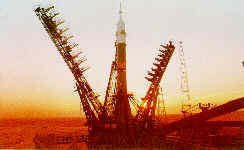 The USSR conducts approximately 100 space launches annually from its three "cosmodromes." One of these, Tyuratam, is the world's largest. To maintain their impressive launch rate, the Soviets have about 20 launch pads and use eight operational types of boosters to launch their payloads. A ninth booster, the SL-X-17, is in development and testing. Their high launch rate allows the Soviets to maintain an increasing number of active satellites in orbit up from about 120 in 1982 to about 150 in 1987. At least 90 percent of the Soviet satellites in orbit have military purpose and can support offensive or defensive operations.
The USSR conducts approximately 100 space launches annually from its three "cosmodromes." One of these, Tyuratam, is the world's largest. To maintain their impressive launch rate, the Soviets have about 20 launch pads and use eight operational types of boosters to launch their payloads. A ninth booster, the SL-X-17, is in development and testing. Their high launch rate allows the Soviets to maintain an increasing number of active satellites in orbit up from about 120 in 1982 to about 150 in 1987. At least 90 percent of the Soviet satellites in orbit have military purpose and can support offensive or defensive operations.
 Although the Soviets steadfastly maintain they have no military space program, about 150 of the approximately 200 operational Soviet satellites projected to be in orbit by the mid-199Os will most likely have purely military missions such as ocean reconnaissance
and targeting, electronic intelligence, imagery reconnaissance, and communications. Another 40 will probably support joint military-civilian functions, including communications, navigation, and weather data. The approximately 10 remaining satellites are likely to conduct interplanetary probes and other scientific missions. The lifetimes and survivability of Soviet satellites are expected to increase during the next 10 years because of more sophisticated technology and the placement of satellites at higher altitudes.
Although the Soviets steadfastly maintain they have no military space program, about 150 of the approximately 200 operational Soviet satellites projected to be in orbit by the mid-199Os will most likely have purely military missions such as ocean reconnaissance
and targeting, electronic intelligence, imagery reconnaissance, and communications. Another 40 will probably support joint military-civilian functions, including communications, navigation, and weather data. The approximately 10 remaining satellites are likely to conduct interplanetary probes and other scientific missions. The lifetimes and survivability of Soviet satellites are expected to increase during the next 10 years because of more sophisticated technology and the placement of satellites at higher altitudes.
The Soviets continue developing and deploying space systems designed to support military operations on Earth. They now have a fully operational network dedicated to warning them of an ICBM attack, and they operate several types of space-based reconnaissance systems. Two of these, the RORSAT and EORSAT, can be used to locate naval forces. Moreover, the Soviets practice their detection and targeting techniques, routinely launching these satellites to monitor both their own and NATO naval exercises.
 Moscow continues to expand its sophisticated satellite reconnaissance program. Several planned improvements such as a data-relay satellite system could improve the timeliness of Soviet intelligence. Demonstrations of flexibility and versatility in launching and deploying surveillance systems have continued, and the Soviets are capable of redirecting them for worldwide missions as required. Meanwhile, their satellite imagery reconnaissance capability has been refined, and space-based electronic intelligence is being upgraded.
Moscow continues to expand its sophisticated satellite reconnaissance program. Several planned improvements such as a data-relay satellite system could improve the timeliness of Soviet intelligence. Demonstrations of flexibility and versatility in launching and deploying surveillance systems have continued, and the Soviets are capable of redirecting them for worldwide missions as required. Meanwhile, their satellite imagery reconnaissance capability has been refined, and space-based electronic intelligence is being upgraded.
While the Soviets are expected to maintain their current launch-detection satellite network, they are probably working on a space-based surveillance system to detect the launch of US SLBMs, as well as European and Chinese missile launches. Although the USSR's land-based ballistic missile defense radar network permits detection of in flight SLBMs, a space-based geosynchronous launch-detection satellite system could increase warning time significantly. The Soviets will probably have the technical capability to deploy such a satellite system within the next several yearn
The Soviets continue deploying their space-based global navigation satellite system known as GLONASS. This system will probably provide highly accurate positioning data for military and civilian users by 1992. GLONASS is similar to the US NAVSTAR Global Positioning System (GPS). In fact, the Soviets used digital signal-processing data from GPS documents to develop GLONASS. GLONASS is being placed in a GPS-like orbit. Based on the 9 to 12 satellites announced for the system, GLONASS would have a worldwide, two-dimensional navigation capability. If the Soviets want GLONASS to provide worldwide, three-dimensional navigation upgrades, they would have to orbit 18 to 24 satellites.
The Soviets have continued developing and deploying radar-carrying satellite systems. Designed for mapping ice formations in polar regions, these satellites can greatly enhance the Soviet Navy's ability to operate in icebound areas by facilitating navigation of northern sea routes and assisting in such activities as routing naval ships from construction yards in the western USSR to new ports in the Pacific.
In July 1987, the Soviets orbited a very large, new type satellite using their PROTON booster rocket. According to the Soviets, COSMOS-1870 has an Earth-resources, remote-sensing mission, which reportedly includes experiments related to hydrology, cartography, geology, agriculture, and the environment. It uses an on board radar unit to gather data. Since no scientific data attributed to this spacecraft has even been discussed or publicly acknowledged to date, a strong military affiliation cannot be ruled out.
 The Soviet manned space program occupies a unique position in Moscow's space efforts. It is heavily publicized to promote the perception of the peaceful nature and technological superiority of the USSR's space program. Nonetheless, the Soviets have made a strong commitment to using their manned space program to accelerate their drive to achieve military superiority in space. For the Soviets, having a man in space provides unique observation, experimentation, execution,and command functions which the US frequently uses remote systems to perform.
The Soviet manned space program occupies a unique position in Moscow's space efforts. It is heavily publicized to promote the perception of the peaceful nature and technological superiority of the USSR's space program. Nonetheless, the Soviets have made a strong commitment to using their manned space program to accelerate their drive to achieve military superiority in space. For the Soviets, having a man in space provides unique observation, experimentation, execution,and command functions which the US frequently uses remote systems to perform.
Soviet literature indicates that the military applications of remote sensing, oceanography, meteorology, and geodesy have been the focus of repeated cosmonaut investigations. Even civil investigations such as astronomical observations, also performed by cosmonauts, have military uses. The USSR may be using such investigations to develop techniques useful for maintaining the orientation of certain equipment to an accuracy of a few arc-seconds, a capability needed to aim directed energy weapons.
The ability to rendezvous and link up with uncooperative spacecraft, which Soviet cosmonauts demonstrated in 1985 and 1986, also has military applications. Cosmonauts use equipment such as a laser range finder, a night-vision device, and an optical sensor while performing this type of operation. The Soviets state that this rendezvous procedure will allow the rescue of cosmonauts stranded in orbit, but it could also be useful both for repairing friendly satellites and for inspecting and disabling enemy satellites.
A crucial cosmonaut activity is Earth observation, which has applications for reconnaissance and targeting. The Soviets report that their cosmonauts have used visual observations, cameras, spectrometers, and multispectral electro-optical sensors in their observations from the SALYUT and MIR space stations. These experiments suggest the Soviets are evaluating their ability to locate, identify, and track targets from outer space. Developing this ability could be the first step toward designing a space weapons platform for use against targets in space and on Earth. Such a platform may eventually be used for ASAT and ballistic missile defense operations, as well as for space station defense.
In 1986, the USSR launched a new-generation space station MIR to replace the aging SALYUT-7. MIR is an impressive advancement over SALYUT-7, having enhanced solar energy and electrical power systems, greater computer capabilities, and individual"cabins" for crew members. Most significantly, while SALYUT-7 had only two docking ports, MIR has six.
With the launch of MIR, a space station module, and regular crew rotations with the SOYUZ-TM capsule, the Soviets have probably begun their permanent manned presence in space. The crew launched in February had a partial crew change in July 1987, and the remaining cosmonaut, Colonel Yuri Romanenko, was relieved in December 1987 after setting two space endurance records. In the early-to-mid 1990s, the Soviets should be able to construct a very large modular space station. They have discussed housing up to 100 cosmonauts in such a space complex.
In addition to space programs which could be construed as having both military and civilian applications, the Soviets have space systems that are purely military in nature. Indicative of the Soviet military program for space is their development and maintenance of the world's only currently operational ASAT system, a ground-based orbital interceptor. Using a radar sensor and a pellet-type warhead, the interceptor can attack all current low-altitude satellites. A target engagement during the first orbit of the intercept leaves little time for a target satellite to take evasive action. The interceptor can reach targets orbiting at an altitude of more than 5,000 kilometers, but it is probably intended for high-priority satellites at lower altitudes.
The ASAT interceptor is launched from Tyuratamon on SL-11 launch vehicles. Two launch pads, storage space for many interceptors, and the launch vehicles are available at the Tyuratam facility. Several interceptors could be launched each day from each of the pads.
Given the complexity of launch, target tracking, and radar-guided intercept, the Soviet ASAT system is far from primitive. Soviet ASAT tests have been largely successful, providing them with an operational system fully capable of performing its mission. Although the Soviets have not launched their ASAT system in several years, in an effort to forestall US development of an ASAT weapon, they have maintained their ASAT readiness. Over the past several years,the Soviets have routinely launched the SL-11 ASAT booster with other payloads, thereby ensuring the reliability of this system component. Other components can be tested on the ground without actually having to launch the ASAT system itself. The nuclear-armed GALOSH ABM also has an inherent ASAT capability against low-altitude satellites. The Soviet Union also has ground-based lasers with some capability to irradiate US satellites.
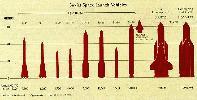 The Soviet space program's success is due largely to its versatile and reliable inventory of space launch vehicles (SLVs) and its space launch and support facilities. The Soviets send a satellite aloft every three or four days, using one of eight types of operational SLVs. The USSR's impressive ability to launch various spacecraft quickly gives the Soviets a distinct operational military advantage in any crisis. Most malfunctioning satellites could be rapidly replaced, and additional satellites could be launched to cover new or expanding areas in a crisis. In fact, if all deployed Soviet satellites were destroyed, the Soviets have sufficient standby lift capability to replace them within two to three months, provided reserve satellites were available.
The Soviet space program's success is due largely to its versatile and reliable inventory of space launch vehicles (SLVs) and its space launch and support facilities. The Soviets send a satellite aloft every three or four days, using one of eight types of operational SLVs. The USSR's impressive ability to launch various spacecraft quickly gives the Soviets a distinct operational military advantage in any crisis. Most malfunctioning satellites could be rapidly replaced, and additional satellites could be launched to cover new or expanding areas in a crisis. In fact, if all deployed Soviet satellites were destroyed, the Soviets have sufficient standby lift capability to replace them within two to three months, provided reserve satellites were available.
 Even with their current launch capability, the Sovietsare expanding their extensive family of SLVs with
new expendable launch vehicles and reusable manned spacecraft. The deployment of the medium-lift Titan IIIC-Class SL-16 and the heavy-lift Saturn V-Class SL-X-17 will increase the payload weight of satellites the Soviets will be able to orbit.
Even with their current launch capability, the Sovietsare expanding their extensive family of SLVs with
new expendable launch vehicles and reusable manned spacecraft. The deployment of the medium-lift Titan IIIC-Class SL-16 and the heavy-lift Saturn V-Class SL-X-17 will increase the payload weight of satellites the Soviets will be able to orbit.
On 15 May 1987, the Soviets conducted the first flight test of the SL-X-17, which they designated "Energiya"(Energy). They openly announced that "military experts took part in creating and testing" the new launch vehicle. The Soviets reported that "Energiya's" first stage (the strap-on boosters) and the second stage (the core vehicle) operated as planned. They also stated that an attempt was made to orbit a satellite during this test. The satellite mockup engines apparently did not function properly and the satellite splashed down in the Pacific Ocean. The failure of the payload, however, was not due to problems with the booster, which performed as intended.
 The SL-X-17 heavy-lift vehicle will be used to launch the Soviet space shuttle orbiter as one of its payloads. Launch-pad compatibility testing of an orbiter attached to the SL-X-17 vehicle may already have taken place, and it appears that a test flight will occur soon. By using US propulsion, computer, materials, and airframe
technology and designs, the Soviets were able to produce an orbiter years earlier, and at far less cost, than if they had depended solely on their own technology and engineering.
The SL-X-17 heavy-lift vehicle will be used to launch the Soviet space shuttle orbiter as one of its payloads. Launch-pad compatibility testing of an orbiter attached to the SL-X-17 vehicle may already have taken place, and it appears that a test flight will occur soon. By using US propulsion, computer, materials, and airframe
technology and designs, the Soviets were able to produce an orbiter years earlier, and at far less cost, than if they had depended solely on their own technology and engineering.
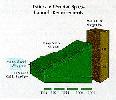 Development of a heavy-lift launch system with its main engines on the core vehicle rather than the orbiter gives the system the versatility to launch either an orbiter or other very heavy payloads. The SL-X17, for example, will be able to place payloads of over 100,000 kilograms into low-Earth orbit, a figure comparable to that carried by the discontinued US
Saturn V rocket. Potential payloads for the SL-X-17 include modules for a large space station, components for manned and unmanned interplanetary missions, and perhaps directed-energy ASAT and ballistic missile defense weapons and other space-based components of the Soviet strategic defense program.
Development of a heavy-lift launch system with its main engines on the core vehicle rather than the orbiter gives the system the versatility to launch either an orbiter or other very heavy payloads. The SL-X17, for example, will be able to place payloads of over 100,000 kilograms into low-Earth orbit, a figure comparable to that carried by the discontinued US
Saturn V rocket. Potential payloads for the SL-X-17 include modules for a large space station, components for manned and unmanned interplanetary missions, and perhaps directed-energy ASAT and ballistic missile defense weapons and other space-based components of the Soviet strategic defense program.
 The SL-16 booster is capable of placing a payload of more than 15,000 kilograms into low-Earth orbit. This capability filled a gap in the Soviet SLV inventory by providing an economical means of launching medium weight payloads. One candidate payload for the SL-16 could be a space plane, a subscale version of which has been flight-tested in orbit; a full-scale test version is possibly in production. A small, manned spacecraft could be used for quick-reaction, real-time reconnaissance missions, satellite repairs and maintenance, crew transport, space station defense, satellite inspection and, if necessary, satellite destruction.
The SL-16 booster is capable of placing a payload of more than 15,000 kilograms into low-Earth orbit. This capability filled a gap in the Soviet SLV inventory by providing an economical means of launching medium weight payloads. One candidate payload for the SL-16 could be a space plane, a subscale version of which has been flight-tested in orbit; a full-scale test version is possibly in production. A small, manned spacecraft could be used for quick-reaction, real-time reconnaissance missions, satellite repairs and maintenance, crew transport, space station defense, satellite inspection and, if necessary, satellite destruction.
The introduction of the SL-16 and SL-X-17, coupled with an expected greater use of the SL-12 and SL-13SLVs, will increase substantially the payloads the Soviets will be capable of launching into space. In fact, during the next five years, the Soviets are expected to double the annual payload weight launched into orbit, and quadruple that weight within 15 years.
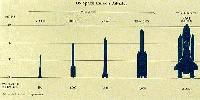 While the INF Treaty marks an important step in reducing the threat of nuclear war, the residual
Soviet nuclear arsenal will still contain some 1,400 ICBMs, nearly 1,000 SLBMs, and a large number of cruise missiles, short-range ballistic missiles, and tactical missile and artillery systems.
While the INF Treaty marks an important step in reducing the threat of nuclear war, the residual
Soviet nuclear arsenal will still contain some 1,400 ICBMs, nearly 1,000 SLBMs, and a large number of cruise missiles, short-range ballistic missiles, and tactical missile and artillery systems.
Even if a strategic arms reduction treaty is concluded and ratified, the Soviets can be expected to continue to improve their strategic nuclear weapons, especially for accuracy, mobility, and survivability. Their short-range ballistic missile force, which is expected to grow steadily, will remain a potentially devastating strike force. Continued Soviet development of a new class of cruise missiles with greater accuracy than currently deployed ballistic missiles will enhance the deep-strike capability of theater bombers and increase bomber survivability by providing a standoff capability. Furthermore, the Soviets show no sign of abandoning any aspect of their strategic defense program, despite its approximate $20 billion per year cost.
Research and development trends suggest that the Soviets fully intend to use space for both offensive and defensive purposes. If current trends continue, space will become the fastest growing industry in both the military and civil sectors, although all available evidence suggests that military requirements drive the Soviet space program.